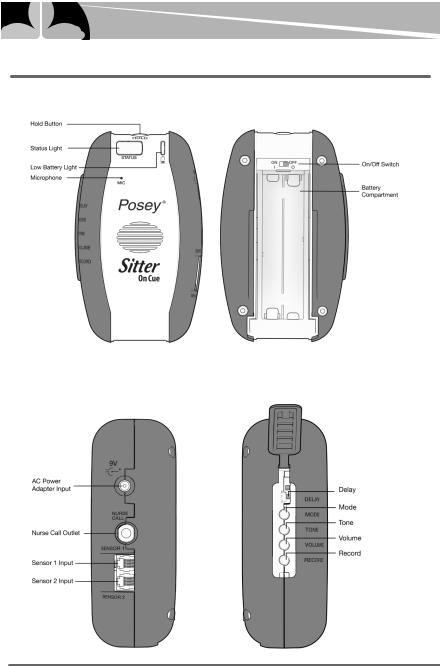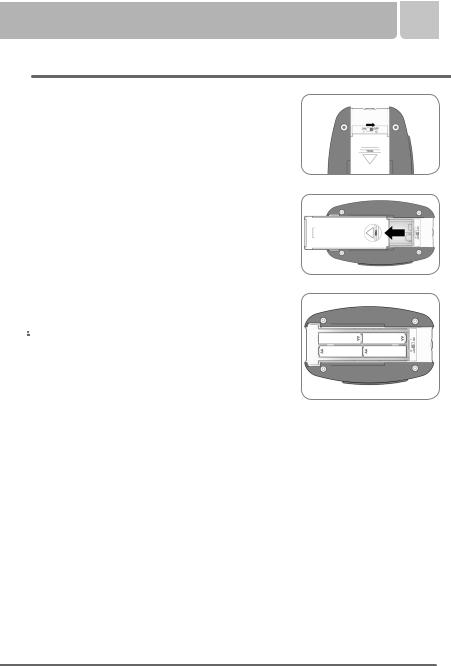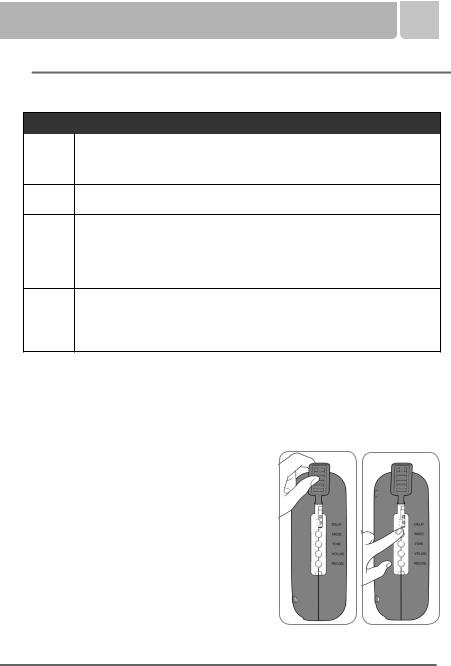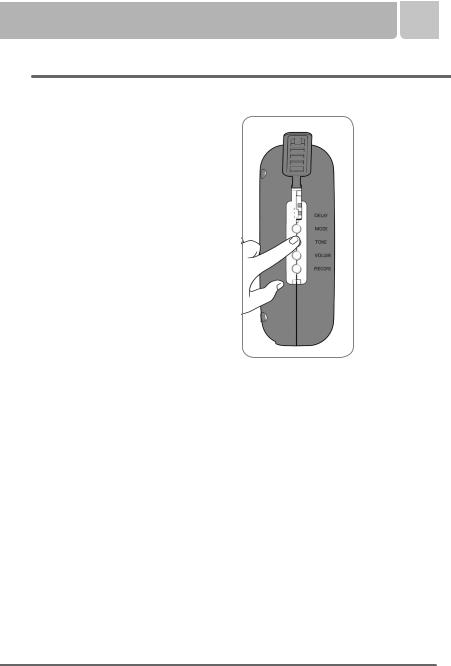Posey 8645 User Manual

Sitter On Cue®
Instruction Manual
The Posey Sitter On Cue Alarm is an important part of your falls management program.
Ensure all parts of this system are operational before leaving a patient unattended.
8645
Before using the Posey Sitter On Cue, read this entire manual and save for future reference.

Contents |
|
Before You Begin.......................................................................................................................... |
3 |
Features of the Sitter On Cue and the Sitter On Cue AC System................................................. |
4-6 |
Preparing the Sitter On Cue for Use........................................................................................... |
7-8 |
Setting Alarm Mode................................................................................................................. |
9-10 |
Setting Alarm Tone..................................................................................................................... |
11 |
Adjusting Alarm Volume.............................................................................................................. |
12 |
Time Delay................................................................................................................................. |
13 |
To Record a Message................................................................................................................. |
14 |
The HOLD Button ................................................................................................................. |
15-16 |
Connecting to AC Power (Optional).............................................................................................. |
17 |
Nurse Call Interface............................................................................................................... |
18-19 |
Monitoring with a Sensors..................................................................................................... |
20-21 |
Monitoring with Two Sensors...................................................................................................... |
22 |
The Sitter On Cue and Use of Physical Restraints........................................................................ |
23 |
Warnings and Cautions.......................................................................................................... |
24-25 |
Mounting the Sitter On Cue................................................................................................... |
26-28 |
Alarm Cleaning, Storage and Battery Maintenance...................................................................... |
29 |
Troubleshooting Guide.......................................................................................................... |
30-32 |
Alarm Specifications and Warranty.............................................................................................. |
33 |
2 |
www.posey.com 1.800.447.6739 |
Sitter On Cue |

BEFORE YOU BEGIN
Before You Begin
The Posey Sitter On Cue is an easy to use, restraint-free addition to your falls management program. The Sitter On Cue provides an early warning when a patient attempts an unassisted exit from a sensor. This system does not prevent falls or injury from falls and is not a substitute for patient care, rounding and a comprehensive falls management protocol in your facility.
The Sitter On Cue activates as the patient attempts to rise and removes pressure from the sensor. The Sitter On Cue may be used with an optional cable to connect to the nurse call system.
Indications for Use:
Persons who may benefit from the use of the Posey Sitter On Cue include:
•Patients with diminished cognitive or mobility skills.
•Patients receiving medications that may cause disorientation, drowsiness, dizziness, or frequent urination
•Patients (new or existing) with a history of falls, or who are assessed to be at risk of falling based on your selected fall-risk assessment
•Patients who are restless or prone to get up in the middle of the night, e.g., due to incontinence, or with nighttime voiding habits
•Patients who require mandatory bed rest
Contraindications:
NOTE: The Sitter On Cue may not be suitable for all high fall-risk patients. See Posey catalog for other options for such patients.
The Sitter On Cue should NEVER be used as the only means of surveillance for:
•Agitated, combative or suicidal patients
•Patients at extreme risk of a life-threatening fall
Response Policy:
Make sure your facility has a clearly defined falls management policy
• Check alarm function every time before leaving patient unattended.
If the alarm and/or sensor do not function properly, remove the alarm and sensor from service and replace them with a properly functioning alarm and/or sensor. DO NOT use the alarm or sensor if it does not activate each time weight is removed from the sensor or the chair belt sensor is unfastened.
Sitter On Cue |
www.posey.com 1.800.447.6739 |
3 |

FEATURES
Features of the Sitter On Cue
FRONT VIEW |
REAR VIEW |
|
(OPEN BATTERY DOOR) |
RIGHT SIDE VIEW |
LEFT SIDE VIEW |
4 |
www.posey.com 1.800.447.6739 |
Sitter On Cue |

FEATURES
Features of the Sitter On Cue (Cont.)
•Seven alarm tones. There are seven different alarm tone options which can be used in different patient rooms, or to discern between different caregivers or levels of fall risk for easy patient identification.
•Four alarm modes. Four alarm modes allow for facility choice regarding caregiver notification in the event the alarm is triggered. The alarm modes are “Voice and Tone”, “Tone Only”, “Voice Only” and “Mute.”
•Three alarm volumes. Three alarm volume settings allow for facility choice regarding caregiver notification in the event the alarm is triggered. The volume options are low, medium and high.
•Custom Recording. Allows a family member, friend or caregiver to record a personal message that will sound if pressure is removed from the sensor pad or chair belt sensor is unfastened. The recording will play only if the alarm mode is set to “Voice” or “Voice and Tone”. This feature can provide patient communication in their language, or by a caregiver or family member for familiarity.
•HOLD Button. Allows you to remove a patient from a sensor pad without the need to turn off the alarm (e.g. for therapy, toileting or socializing). Alarm will resume monitoring when patient returns to the sensor pad.
•Optional alarm delay of 0, 1, or 2 seconds. Allows you to adjust alarm timing for each patient. The delay allows you to determine, by alarm, the number of seconds between the time pressure is removed from the sensor, chair belt sensor is unfastened, and the time the alarm activates.
•Dual Sensor monitoring. This alarm connects to any Posey sensor pad, (chair, toilet, commode, stretcher, over-mattress and chair belt sensors). Alarm activates when weight is removed from sensor pad, or chair belt sensor is unfastened. Two sensors can be connected to the alarm at the same time.
•Nurse Call Interface. Provides alarm notice at patient’s room and nursing station. If connected to nurse call, the Sitter On Cue has the ability to be muted, silencing the alarm at the patient’s bedside. It will still alarm at nurse call system notification points.
•Failsafe sensor alarm. The Posey Sitter On Cue activates if the alarm is on and a sensor cord is removed from the alarm.
•Battery operated. The alarm utilizes four (4) “AA” alkaline batteries.
•Visual and Audible low battery warning. Low battery LED will blink red when batteries are low and an audible cue will say “low battery” when batteries are critically low, alerting caregivers of the need to change batteries.
•DC Jack. For AC connection.
•AC Adapter. The Sitter On Cue 8645 adapter connection enables users to operate on AC electrical power.
•Impact resistant cover. Helps minimize damage if dropped.
 NEVER connect other manufacturers’ sensors to a Posey alarm. Use of another manufacturer’s sensors may damage the Posey alarm, cause the fall monitoring system not to function as intended, and will void the factory warranty.
NEVER connect other manufacturers’ sensors to a Posey alarm. Use of another manufacturer’s sensors may damage the Posey alarm, cause the fall monitoring system not to function as intended, and will void the factory warranty.
Sitter On Cue |
www.posey.com 1.800.447.6739 |
5 |

CONTENTS AND BRACKET OPTIONS
Each Sitter On Cue is shipped to you with:
•Alarm (1)
•“AA” Alkaline batteries (4)
•8276 Bracket and Clip
•Instructions for Use
NOTE: If you require the ability to run on AC power, order 8645AC.
See the Posey catalog for additional accessories sold separately, including a variety of brackets and nurse call cable sets.
6 |
www.posey.com 1.800.447.6739 |
Sitter On Cue |

Preparing the Sitter On Cue for Use
Battery Installation:
The battery-operated Sitter On Cue is portable and long lasting. Fresh alkaline batteries have an estimated life of 30 days of daily use. Actual life depends on alarm mode, tone and volume you select.
1. Slide the power switch to the OFF position before inserting/
changing batteries (Fig. 1). |
Fig. 1 |
||||
2. Press down on the arrow and slide the battery compartment |
|||||
|
|||||
door completely off (Fig. 2). Set battery door aside. |
|
||||
3. Insert four (4) new “AA” alkaline batteries as pictured inside |
|
||||
the battery compartment (Fig. 3). Take care not to damage |
|
||||
battery contacts. |
|
||||
4. Reattach the battery compartment door. Slide it shut, locking |
|
||||
it into place. |
|
||||
Alarm Low Battery LED will blink red when batteries are low |
Fig. 2 |
||||
|
|||||
and an audible cue will say “low battery” every 15 seconds |
|
||||
when batteries are critically low. Change batteries at once. |
|
||||
|
|
|
|
||
|
|
|
|
|
|
• Take care when installing new batteries. The alarm will |
|
||||
not work if batteries are installed improperly. |
|
||||
• ALWAYS install a completely new set of batteries |
|
||||
when the Low Battery LED is blinking red. DO NOT |
|
||||
replace a single cell, but all cells in the alarm. DO NOT |
Fig. 3 |
||||
mix old and new batteries, or battery brands within |
|||||
a battery pack (4 batteries). Use of mixed batteries, |
|
||||
battery leakage, or batteries installed incorrectly may cause battery damage, and may damage the alarm. Remove any alarm from use and send to the appropriate facility authority if batteries are damaged or corroded or the battery compartment has signs of previous battery corrosion such as white powder residue.
•Batteries can explode or leak and cause damage to alarm if installed incorrectly, fully discharged, or exposed to liquid, fire or high temperatures. If battery damage has occurred, or you see any corrosion, remove the alarm from use IMMEDIATELY. DO NOT use the alarm if battery damage has been detected.
•After changing batteries, test the alarm and sensor for proper operation prior to putting in service with a patient, and each time before leaving the patient unattended. If the alarm and/or sensor do not function properly, remove the alarm and sensor from service and replace them with a properly functioning alarm and/or sensor.
Sitter On Cue |
www.posey.com 1.800.447.6739 |
7 |

STATUS LIGHT KEY
The Status LED will flash different colors providing a visual indication of the current state of the alarm.
FLASH |
ALARM STATE |
DESCRIPTION |
Green |
Active Monitoring |
Sensor is connected and pressure is being |
|
|
applied to the pad |
|
|
|
Yellow |
Ready |
The sensor will activate and begin monitoring |
|
|
as soon as pressure is applied to a connected |
|
|
sensor |
|
|
|
Rapid Yellow |
Sensor Activation |
When pressure is applied to a sensor, the alarm |
|
|
will rapidly flash yellow for 3 seconds before the |
|
|
sensor is fully activated. |
|
|
|
Red |
Hold |
For 30 seconds after the hold button is pressed, |
|
|
monitoring is suspended. The alarm is not ac- |
|
|
tively monitoring and the alarm will not activate |
|
|
if pressure is removed or applied to from the |
|
|
sensor. |
|
|
|
Rapid Red |
ALARM |
The patient has removed pressure from the pad |
|
|
or another event has occurred that requires a |
|
|
nurse’s attention |
|
|
|
8 |
www.posey.com 1.800.447.6739 |
Sitter On Cue |

SETTING MODE
Setting Alarm Mode
The Sitter On Cue has four (4) alarm modes. These allow you to select an alarm notification best suited to patient and facility needs.
Mode Features
VOICE & Depending on whether a custom voice recording is made, either the factory default TONE voice or a custom voice recorded message plays once, followed by the selected
alarm tone. The tone continues to play until alarm is placed on hold or patient is repositioned with the sensor.
TONE This is the factory default mode. Selected alarm tone plays until alarm is placed on hold or patient is repositioned with the sensor.
VOICE This mode requires the nurse call cable to be plugged into your alarm and the ONLY appropriate wall jack from your nurse call system. Custom voice or factory default
voice message plays repeatedly until alarm is placed on hold or patient is repositioned with the sensor. This mode also activates the facility nurse call system. Automatically switches to VOICE & TONE if a nurse call cable is removed from the alarm.
MUTE This mode requires the nurse call cable to be plugged into your alarm and the appropriate wall jack from your nurse call system. THERE IS NO AUDIBLE VOICE MESSAGE OR ALARM TONE AT THE PATIENT’S BEDSIDE. This mode activates the facility nurse call system. Automatically switches to VOICE & TONE if the nurse call cable is removed from the alarm.



 When using a nurse call cable, ensure the nurse call cable is plugged in to both the alarm and the wall jack before leaving the patient unattended. Verify that an alert is received at the nursing station if the cable is unplugged from the wall jack.
When using a nurse call cable, ensure the nurse call cable is plugged in to both the alarm and the wall jack before leaving the patient unattended. Verify that an alert is received at the nursing station if the cable is unplugged from the wall jack.
NOTE: There will be no alert at the nursing station or at the bedside if the nurse call cable is unplugged from the alarm.
To Change/Select Mode
NOTE: “Voice Only” and “Mute” can be set only when the nurse call cable is plugged into your alarm. With this
feature, all mode options are available. Be sure to plug the nurse call cable into wall and test. YOU MUST PLUG THE NURSE CALL CABLE INTO THE ALARM AND THE WALL JACK IN ORDER TO ACTIVATE NURSING STATION ALERTS.
Follow these steps to change or select alarm mode:
1.Lift the programming control protective cover (Fig. 4).
2.Ensure alarm is on
3.Press MODE button on left side of alarm to scroll through the mode selections (Fig. 5). The last mode heard is the mode utilized when the alarm is activated.
Fig. 4 |
Fig. 5 |
Sitter On Cue |
www.posey.com 1.800.447.6739 |
9 |

SETTING MODE
Setting Alarm Mode (Continued)
4.When “Voice Only” or “Mute” are selected, you must have the nurse call cable plugged into your alarm and the appropriate wall jack for your nurse call system. Ensure that the nurse call system indicators (nursing station and wall light) are activated when the cable is unplugged from the wall jack.
5.Replace the programming control protective cover, securing it into place.
To test the modes requiring nurse call interface, remove pressure from the sensor or unfasten the chair belt sensor. Check at the nurse’s station to ensure that the indicator for the appropriate patient alarms on the nurse call system and the wall light, indicating there is no pressure on the sensor or chair belt sensor is unfastened.
10 |
www.posey.com 1.800.447.6739 |
Sitter On Cue |

SETTING TONE
Setting Alarm Tone
The Sitter On Cue has seven (7) available tones. This allows you to differentiate between patients and other equipment alarms.
To Select Tone:
1.Lift the programming control protective cover (Fig. 7).
2.Ensure alarm is on
3.Alarm mode must be set to either “Voice and Tone” or “Tone” (see pages 9-10) in order to hear the selection.
4.Press TONE button on left side of alarm to scroll through the tone selections (Fig. 8).
5.Each time you press the button, tone will change and a sample plays. The last sample heard is the tone utilized when the alarm is activated.
6.Replace the programming control protective cover, securing it into place.
Fig. 8
Sitter On Cue |
www.posey.com 1.800.447.6739 |
11 |
